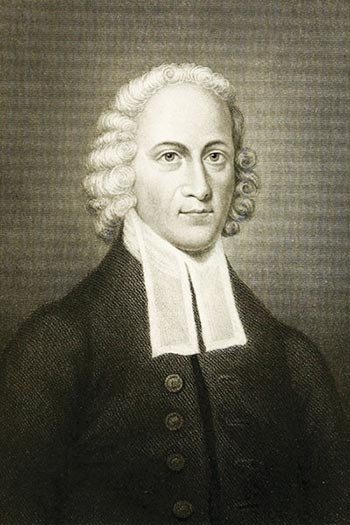Jonathan Edwards 1703-1758

Jonathan Edwards
There is no doubt the Jonathan Edwards well deserves the description “The Theologian of Revival”. His works on the subject still remain the most sensible, wise and biblical handbooks on experiential revival ever penned. He is universally recognised as ‘one of the best theological minds’ America has ever produced and ‘his reflections on the nature of genuine religion and advocacy for experiential Calvinism influenced generations of Christians. (A. Scott Moreau, Baker Evangelical Dictionary of World Missions)
He was no stranger to revival. When he was just twelve years old (in 1715) the church his father, Rev. Timothy Edwards, pastored experienced a “remarkable stirring and pouring out of the Spirit of God resulting in an unusual number of conversions (for these days) and many more awakened to the condition of their souls.”
His maternal grandfather, Solomon Stoddard (1643-1729), also a minister, similarly enjoyed five distinct periods of spiritual awakening at Northampton, New Hampshire in 1679, 1683, 1696, 1712 and 1718. Young Jonathan was nine and fifteen years old respectively during the last two seasons of revival and refers to his knowledge of these times in his “Faithful Narrative”, written in 1735.
Furthermore, we know he was exposed to the revival writings of a number of other men of God. Many of his Puritan predecessors were post-millennialsts, believing the Scriptures taught the world-wide success of the Gospel before the return of Christ. He read sermons by John Howe (1630-1705) which touched on this subject and he refers to Robert Flemming’s (1630-1694) “The Fulfilling of the Scripture” where a number of religious awakenings in Britain were recounted.
But the best was yet to come! In 1727, after five years of ministry life, he was invited to co-pastor with his eighty-three year old grandfather at Northampton, Massachusetts. Two years later Stoddard went home to glory leaving his grandson as sole pastor.
In 1734-35 revival hit the town. It was directly related to Edward’s preaching and resulted in a variety of supernatural experiences and many conversions. In his “Faithful Narrative of Surprising Conversions,” a report on this revival work, he describes some of these unusual supernatural happenings and was obviously developing some of the revival insights he later published. It was this revival, and Edwards’ reporting of it, that provoked others on both sides of the Atlantic to seek God in prayer for a move of God in their days. They were not disappointed. Under the leadership of men like Edwards, George Whitefield and John Wesley, the church grew very rapidly. In New England alone ten percent of the total population of 300,000 were added to the churches between 1740 and 1742. During this time 150 new congregations were formed by Congregational pastors alone in twenty years. One historian called the work ‘the most glorious and extensive revival of religion and reformation of manners’ the country had ever known (quoted in J. Edwin Orr’s ‘The Re-study of Revival and Revivalism’ 1981.)
In 1740-42 Northampton again experienced a gracious outpouring of the Spirit, but this time it was far more widespread, spreading throughout New England. Moved by fierce criticism and pastoral concerns, he applied his sharp mind, Biblical knowledge and spiritual wisdom, to the task of writing some major works on the Biblical theology of revival and on spiritual discernment in revival times. “A History of the Work of Redemption” was preached in 1739 and published in 1744. “The Distinguishing Marks of a Work of the Spirit of God” was published in 1741. A year later there followed “Thoughts of the Revival of Religion in New England in 1740”. The “Treatise on the Religious Affection”, a series of sermons preached in 1742-3, was published in 1746. In 1747 he published “An Humble Attempt to Promote Explicit Agreement and Visible Union of God’s People in Extraordinary Prayer for the Revival of Religious and the Advancement of Christ’s Kingdom on Earth”.
As a whole, his six books on revival provided the evangelical world with the most comprehensive and useful revival observations that had ever been written. No serious student of revival can afford to overlook his massive contribution; and no lover of revival can fail to get inspiration and discernment form his writings.
Edwards, himself, was a powerful preacher of the gospel – not typically flamboyant or theatrical, on the contrary, quite undemonstrative. He usually read his sermons, rarely gesticulated or even moved. He never excited his hearers with illustrations or stories. He simply presented well-structured and well-reasoned sermons with such personal earnestness and clarity that his hearers were swept along on a tide of truth which riveted their attention and deeply affected their lives.
Unfortunately, in 1750, after a time of doctrinal disagreement with his church he was unfairly expelled from the pastorate and in 1751 moved to a mission church working with the Mohawk and Housatonnoc Indians in Stockbridge, Massachesetts. Here, despite further doctrinal controversy, he wrote more notable works like his “Freedom of the Will” and “Original Sin.”
In 1757 he was invited to become President of Princeton College, but soon after he arrived he contracted smallpox, by an inoculation, and went to his reward a month later.
He was a “saint, scholar, preacher, pastor, metaphysician, theologian, Calvinist and revival leader” who has left an indelible work on evangelical Christendom, and has greatly benefited the cause of Christianity. His legacy of advocating missionary efforts, employing wise discernment and leadership in times of revival, the publication of David Brainerd’s journals and his insistence on the relevance of Gospel preaching (in contrast to the almost fatalistic Reformed theology of his time) make him one of the most significant forerunners of the modern missionary movement.
Bibliography: I Will Pour Out My Spirit, R. E. Davies 1997; J. Edwin Orr’s ‘The Re-study of Revival and Revivalism,’ 1981; A. Scott Moreau, Baker Evangelical Dictionary of World Missions 2000.
Tony Cauchi



